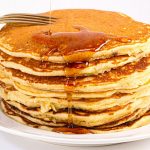 In England, the original pancake was called afroise, a fried cake of dough that often contained bacon. Froise appeared in the early fourteenth century, and may have derived, through French, from the Latin frigere, meaning to fry. Pancake itself appeared in the early fifteenth century, an obvious compound of pan and cake. Although usually considered rather plain fare, pancakes acquired a special, allegorical significance on Pancake Day, also called Shrove Tuesday, the merrymaking holiday preceding Lent: the eggs that went into them symbolized creation; the flour, the staff of life; the milk, purity; and the salt, wholesomeness. Later, pancakes came to be known by dozens of other names. Flapjack appeared early in the seventeenth century, flap being a variant of flip, and jack being a word that meant food in some British dialects. Most of the new words for pancake appeared in the United States: Indian cake appeared in the early seventeenth century for pancakes made from corn meal; at about the same time, the Algonquian word nokehick, meaning it is soft, gave rise to pancake’s most peculiar synonym, no cake. Hot cakes appeared a little later in the seventeenth century, but the phrase to sell like hot cakes can only be traced to the early nineteenth century. Another Native American word, joniken, may be the source of johnnycake, first recorded in the mid eighteenth century. Alternatively, johnnycake may have developed from Shawnee cake, the Shawnee being a tribe of Native Americans in what is now Tennessee, or johnnycake may have developed from the term journey cake, a food prepared in advance and taken along on a long trip. Griddlecake, appearing in the late-eighteenth century, clearly takes its name from the implement it was cooked upon, as might also be the case with the slightly older hoecake, the thin blade of a cotton hoe being a handy cooking surface when a griddle was not available out in the field; however, hoecake might also have evolved from the previously mentioned nokehick as people heard, and then mistook, a “nokehick” for “an hoecake.” Flannel cake, a name that probably derives, like the term flan itself, from the Old French flawn, meaning flat cake, emerged in the late eighteenth century, followed by buckwheat cake in the early nineteenth century. The most recent aliases for the pancake are flat car, which originated among railway workers in the twentieth century, and silver dollar, which seems to have been coined by chain restaurants hoping to sell pancakes that are numerous but tiny.
In England, the original pancake was called afroise, a fried cake of dough that often contained bacon. Froise appeared in the early fourteenth century, and may have derived, through French, from the Latin frigere, meaning to fry. Pancake itself appeared in the early fifteenth century, an obvious compound of pan and cake. Although usually considered rather plain fare, pancakes acquired a special, allegorical significance on Pancake Day, also called Shrove Tuesday, the merrymaking holiday preceding Lent: the eggs that went into them symbolized creation; the flour, the staff of life; the milk, purity; and the salt, wholesomeness. Later, pancakes came to be known by dozens of other names. Flapjack appeared early in the seventeenth century, flap being a variant of flip, and jack being a word that meant food in some British dialects. Most of the new words for pancake appeared in the United States: Indian cake appeared in the early seventeenth century for pancakes made from corn meal; at about the same time, the Algonquian word nokehick, meaning it is soft, gave rise to pancake’s most peculiar synonym, no cake. Hot cakes appeared a little later in the seventeenth century, but the phrase to sell like hot cakes can only be traced to the early nineteenth century. Another Native American word, joniken, may be the source of johnnycake, first recorded in the mid eighteenth century. Alternatively, johnnycake may have developed from Shawnee cake, the Shawnee being a tribe of Native Americans in what is now Tennessee, or johnnycake may have developed from the term journey cake, a food prepared in advance and taken along on a long trip. Griddlecake, appearing in the late-eighteenth century, clearly takes its name from the implement it was cooked upon, as might also be the case with the slightly older hoecake, the thin blade of a cotton hoe being a handy cooking surface when a griddle was not available out in the field; however, hoecake might also have evolved from the previously mentioned nokehick as people heard, and then mistook, a “nokehick” for “an hoecake.” Flannel cake, a name that probably derives, like the term flan itself, from the Old French flawn, meaning flat cake, emerged in the late eighteenth century, followed by buckwheat cake in the early nineteenth century. The most recent aliases for the pancake are flat car, which originated among railway workers in the twentieth century, and silver dollar, which seems to have been coined by chain restaurants hoping to sell pancakes that are numerous but tiny.
A beloved breakfast classic in America, this delectable treat takes the form of a soft, thin cake cooked on a griddle or a well-greased, heated skillet. Traditionally, it is served generously adorned with butter and drizzled with maple syrup, often accompanied by crispy bacon or savory sausages. The roots of American pancakes can be traced back to the indigenous people who skillfully fashioned cornmeal into tender cakes, known as “nokehick.” These cornmeal cakes, along with similar flat cakes brought over by settlers from their homelands, such as the Dutch “pannekoeken,” gradually transformed into the modern pancake we cherish today. This breakfast staple comes in various delightful variations, including buckwheat, buttermilk, johnnycakes, flapjacks, and blueberry pancakes, to name a few. Each version boasts a unique batter, typically consisting of a blend of different flours combined with milk, eggs, and often a touch of butter.
